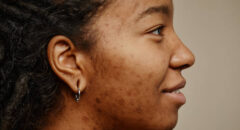
A chronic skin condition responsible for rapid skin cell growth, psoriasis can turn normal healthy-looking skin into something out of a horror movie!
Whether it’s red, scaly patches, burning flesh, stiff joints, or thickened nails, the symptoms of psoriasis are more than enough to interrupt your daily life. Unfortunately for Black individuals, the challenges of this condition often show up in different ways. Patches may appear purple, dark brown, or gray on darker skin, making diagnosis and treatment all the more difficult.
This is why self-assessment tools are so essential. These handy tools can help you monitor the severity and impact of your psoriasis, allowing you and your doctor to make better, more informed decisions.
Here are six critical self-assessment tools you’ve gotta know.
1. Psoriasis Area and Severity Index (PASI)
The Psoriasis Area and Severity Index (PASI) is a popular tool that gives you a good idea of the severity and extent of your condition. Basically, it assesses how much redness, thickness, and scaling you’ve got in your skin lesions, while also letting you know the area of your body affected.
PASI scores can range from 0 to 72. The higher the score, the worse your psoriasis. The index divides the body into four regions: your head, trunk, and upper and lower limbs. The overall score is reached by scoring these regions separately and then tallying.
Any score over 10 is typically considered to be severe.
2. Psoriasis Self-Management Assessment
This tool is designed for individuals who need to evaluate their ability to manage psoriasis day by day. An assessment, this tool uses questions pertaining to your medication use, skin care habits, stress levels, and any lifestyle changes. When you fill out the questionnaire, you rate your confidence and consistency in these areas.
Overall, the Psoriasis Self-Management Assessment is great for knowing where you stand and where you can improve. If you think you need help managing your condition (or aren’t sure), give it a try!
3. Body Surface Area (BSA)
The Body Surface Area (BSA) measurement is all about percentages. It gets a little technical, but basically, it’s used to estimate the percentage of your body affected by psoriasis. Different body parts get different percentages depending on how much of your total body they represent. For instance, your neck might represent 20 percent of all your body surface impacted by psoriasis.
Quick and easy to use, the BSA is also prominent in clinical settings where it guides treatment decisions.
RELATED: 10 Misconceptions About Psoriasis & Black Skin
4. Psoriasis Symptom Inventory (PSI)
The Psoriasis Symptom Inventory (PSI) is one of those tools that takes into account your subjective experience. In other words, it reports how you perceive the severity of your symptoms. The questionnaire works by asking you about things such as scaling, pain, itchiness, etc.
With the PSI, you both rate your symptom severity as well as report how often and strongly each symptom occurs. Thanks to this inventory, you can get a more personalized treatment approach. It is a vital part of overall condition care.
5. Dermatology Life Quality Index (DLQI)
This comprehensive index (DLQI) measures the impact of skin diseases (like psoriasis) on your quality of life. It’s pretty straightforward. You answer 10 questions, each scored from 0 to 3. The higher the score, the harder the condition impacts you. The questions address feelings, activities, work and school, relationships, treatment, and more.
We all know psoriasis affects the physical, but this focus on the psychological is equally important!
6. Psoriasis Area and Severity Index for Palmoplantar Psoriasis (PASI-PP)
The PASI-PP is sorta like the PASI, except it specifically assesses psoriasis on your palms and the soles of your feet. Like the PASI, the PASI-PP evaluates symptoms such as redness, thickness, and scaling. The difference, however, is that it’s particularly adapted for these areas.
Because palmoplantar psoriasis can greatly impact your ability to walk and use your hands, the PASI-PP offers important detailed assessments.
As a result, you get treatment specifically tailored to address these challenges, so that you can get back on your feet!
So find the tool right for you.
Because Black individuals face particular challenges with psoriasis, it’s important that you find the tool that best fits your needs. In many cases, you may end up using multiple tools. While there is certainly overlap, some of these instruments allow for distinct measurements. Whether it’s the BSA, the PSI, the DLQI, or anything else, don’t be afraid to take the dive.
It’s super easy, and if you’re not sure where to begin, just ask your doc. In no time at all, you can get a better hold on your condition and start formulating a treatment strategy perfect for you.








